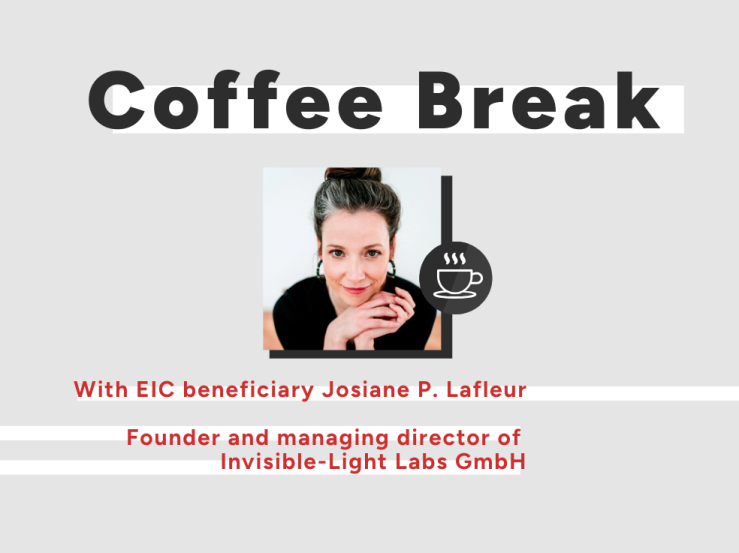Every month, during a Coffee Break, we dive into the stories of EIC innovators and get a glimpse of the people behind EIC projects. Today’s guest is Josiane P. Lafleur, founder and Managing Director of Invisible-Light Labs, spin-off company of the Vienna University of Technology (TU Wien). Through her words, we will learn how the Austrian spin-off's groundbreaking infrared detector was the result of its international team’s varied backgrounds and open-mindedness.
Lastly, do not miss its most recent achievement: the recognition of EMILIE – the device developed for the commercial market through the EIC Transition project NEMILIES – as one of the most important innovations of 2024 by “The Analytical Scientist”.
For starters, as the founder and Managing Director of Invisible-Light Labs, do you think that the highly multidisciplinary and international nature of your research team has played an important role in the creation of Invisible-Light Labs' groundbreaking infrared detector?
Absolutely! Various scientific skills – from chemistry to electronics and nanomechanical systems – were required to build EMILIE, our infrared detector. But the advantage of the highly multidisciplinary and international nature of the team is not limited to the sum of our contributions. It’s also that we all look at, and question, each other’s contributions from a very different angle as our background knowledge is so different! Someone from a different field and perspective can sometimes come up with a completely different idea to solve a problem or with a question that wouldn’t have been considered otherwise.
EMILIE brings nanomechanics and infrared spectroscopy together to form a very unique and powerful tool. Analytical chemists like me usually don’t get access to these tools because they rarely make it out of the niche laboratory where they were developed.
I was met with quite some skepticism by my cofounders when I suggested transforming it into an accessory for commercially available Fourier-Transform Infrared Spectrometers (FTIRs). FTIRs are present in every analytical laboratory, it’s a very widespread technique, and I wanted every analytical scientist to be able to use this new tool with as little effort as possible.
Through the EIC Transition NEMILIES project, you managed to bring the innovative IR detector technology developed during the project out of the lab and into the hands of users in various fields. If you could give a piece of advice to research teams who are just starting a similar transition journey with their technology, which would it be?
I think it is very important to have a realistic view of the road ahead and to avoid comparing one’s progress to that of other tech startups. Every road is different, and that holds especially true to deep-tech hardware spinoffs.
Scientists trying to translate their research out of the lab and into the hands of users will not only spend considerably more time at lower technology readiness levels (TRLs) than software or app-based startups; they will also likely face the challenges and uncertainties of developing new markets.
The lengthy time to market and high capital intensity are very challenging but can be mitigated with good planning, as much outsourcing as possible to keep fixed costs low, and the efficient use of collaborations with universities and industrial partners, for example.
As a first recent achievement, in December 2024, the magazine “The Analytical Scientist” selected the most important innovators of 2024 in the field of analytics and EMILIE took the first place. Could you explain the significance of this reward for Invisible-Light Labs’ team?
This achievement was an incredible validation for us. The goal of the EIC Transition NEMILIES project was to bring this very complex technology out of the niche laboratory and into the hands of users in various fields. This award was for us, really, the confirmation that we had achieved our goal.
It confirmed that experts in the field did consider EMILIE to be an analytical tool that had its place in the modern analytical laboratory. We are extremely proud to have achieved that!
As a second recent achievement, EMILIE is undergoing the final verification of its latest models before being shipped to the first customers. Now that you have almost achieved market readiness, what are Invisible-Light Labs’ goals for the future?
We just signed a collaboration agreement with a leading international FTIR spectrometer manufacturer, which is very exciting as it will help EMILIE enter the international market and rapidly gain more users. I can’t wait to see what scientists worldwide and in various fields can accomplish with EMILIE!
Meanwhile, we have really interesting scientific publications from the first EMILIE users on the characterization of aerosols and nanoplastics coming soon, which are sure to generate interest.
About Invisible-Light Labs
The EIC beneficiary Invisible-Light Labs strives to make a positive impact in the world by enabling groundbreaking scientific discoveries with its highly sensitive EMILIE nanomechanical infrared analyser, developed through the NEMILIES project, funded within the EIC Transition scheme.
Learn more about NEMILIES by visiting CORDIS.

DISCLAIMER: This information is provided in the interest of knowledge sharing and should not be interpreted as the official view of the European Commission, or any other organisation.

